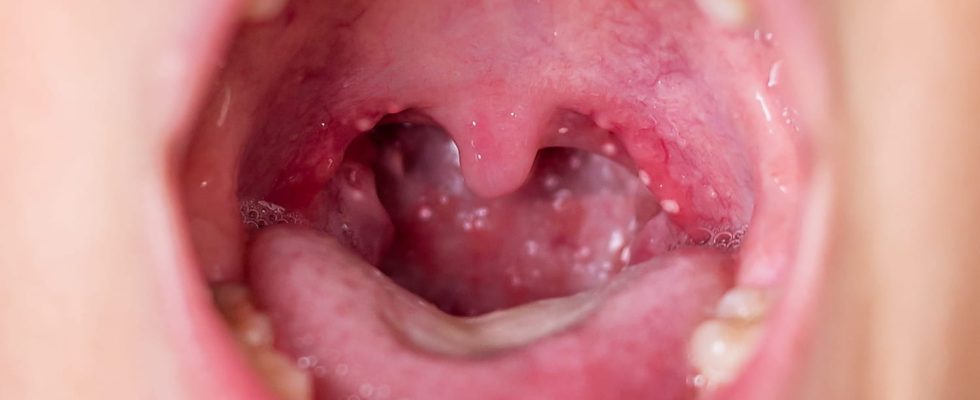Herpetic angina presents as a banal angina, with the sudden appearance on the tonsils of vesicles, symptoms close to those of an HIV infection. Cause, transmission, recurrence, treatment: discovery.
Herpetic angina corresponds to an infection of the pharynx and tonsilscaused by herpes simplex virus. It does not require any special treatment and heals spontaneously in less than ten days. What is herpetic angina? How does she catch it? How to relieve it?
What is herpetic angina?
Herpetic angina is an infection of the pharynx and tonsils, caused by herpes simplex virus. The affected areas are very red with white blisters and small ulcerations that can become canker sores. Most often very painful, there is no no specific treatment for herpetic angina but with proper care she heals spontaneously in 5 to 10 days.
Attention, it is important to differentiate herpetic angina from:
- I’adenovirus angina which, in addition to the pinkish-red color of the pharynx, is accompanied by conjunctivitis.
- Iherpanginaerythematous vesicular angina due to coxsackievirus infection, is accompanied by a skin rash.
- Primary HIV infection. Herpetic angina must be differentiated from primary HIV infection, which can also be accompanied by redness and edema of the pharynx, mouth ulcers and enlarged lymph nodes with associated muscle pain. .
- Hand-foot-mouth syndrome due to a Coxakie virus which manifests as vesicular stomatitis associated with a vesicular eruption of the lateral edges of the feet and fingers.
What is the cause of herpetic angina?
Herpetic angina, as its name suggests, is caused by the herpes virus (Herpes simplex virus). It is one of the most common viral anginas, along with herpangina.
Is herpetic angina contagious?
Whatever the type, angina vesicularis is very contagious.
What are the symptoms of herpetic angina?
Herpetic angina starts suddenly with a high fever up to 40°C. The patient has trouble swallowing because of the pain felt, which can affect not only the throat but also the ears with sometimes dizziness. The throat and tonsils are bright red or pinkish in color, with small blisters or rounded bumps. As herpetic angina progresses, small ulcerations appear (small loss of substance) covered with white spots with bright red edges. “Note that herpetic angina is often associated with herpes lesions in the lips, oral cavity and/or nostrils. Gum disease is possible, especially in children. Neck glands increase volume and most often are painful” emphasizes Doctor Marie-Paule Morisseau-Durand, ENT pediatrician at the Clinique Marcel Sembat in Boulogne-Billancourt (92).
Herpetic angina in babies
Herpetic angina is most often the extension to the tonsil of herpetic gingivo-stomatitis. It is most often due to HSV1. “Primary herpetic infection is the first expression of this, notes Dr. Morisseau-Durand. It is observed in children from 6 months to 5 years old, in 50% of cases before the age of 2 years. It begins after a high fever, with clusters of vesicles which turn into painful whitish erosions on the gums then in the oral cavity, the soft palate, the tonsils. The child drools a lot and refuses to eat. Tender lymph nodes are palpable in the neck.” The evolution is most often benign in 10 to 14 days. In infants, it is due to HSV2.
Herpetic angina in pregnant women
There is no passage of virus during pregnancy to the fetus which does not risk anything. It is at the time of birth only if the mother has an outbreak of herpes with visible blisters on her genital tract that the newborn could be infected when passing through the vagina by fluid contact with the eyes, nose, mouth or other unprotected part by healthy skin.
There is no specific treatment for herpetic angina. This condition heals spontaneously in a few days without leaving any sequelae. However, due to the severity of the symptoms, treatment for pain and fever (analgesics for pain, antipyretics for fever such as paracetamol taken systematically every 6 hours) is necessary as well as a diet adapted to the difficulties of swallowing. In case of superinfection, the doctor may prescribe an antibiotic.
What are the risks of complications?
Locally there may be a secondary infection, which may require antibiotic therapy. General complications are rare but serious, especially in children: brain and ocular complications are possible. “It is also absolutely necessary to avoid contact between a child with dry skin weakened by an allergy and a child carrying a primary herpes infection. In fact, herpes can spread to the face and to the whole body”, warns the expert. Finally, herpes can become recurrent: the appearance is identical but more attenuated. It heals in 7 days.
What to eat in case of herpetic angina?
Herpetic angina is painful and can cause difficulty in swallowing (“swallowing”) solid foods. It’s necessary favor a cold or even frozen diet, soft and non-acidic throughout the duration of the infection. On the other hand, it is necessary drink plenty of water to avoid dehydration.
Thanks to Doctor Marie-Paule Morisseau-Durand, ENT pediatrician at the Marcel Sembat Clinic in Boulogne-Billancourt (Ramsay Générale de Santé group).
